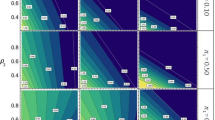Abstract
Extreme sampling of sibling pairs has been shown to be efficient in terms of statistical power and sample sizes (in number of sibling pairs needed to genotype) to detect a quantitative trait locus (QTL) when the residual distribution is normal. In the present study, the efficiency of extreme sampling strategies to detect each locus under an oligogenic model is analytically explored with a test statistic based on identical-by-descent (IBD) statuses of independent sibling pairs. In the oligogenic model, the joint effect of oligogenes is the sum of the effects of each locus. Under this model, detecting each single locus will depend, in part, on the allele frequencies and magnitudes of effect of the other loci. Effects of two QTLs with different magnitudes of displacement and acting nonepistatically are considered. Three types of extreme sampling—that is, extreme concordant high (ECH), extreme concordant low (ECL), and extreme discordant (ED)—are primarily considered herein. Among these, ED sampling under the oligogenic model is shown to be most efficient in most situations considered here in terms of allele frequency and mode of inheritance. Differences in results between ECH and ECL sampling are purely arbitrary, brought up mostly by the directions of displacement effects. However, power to detect a locus with the lesser (in magnitude) displacement effect does not necessarily increase with extremity of sampling. Combinations of extreme discordant and extreme concordant sibling pairs are briefly discussed.
Similar content being viewed by others
REFERENCES
Abrahams, N. M., and Alf, E. F. (1978). Relative costs and statistical power in the extreme groups approach. Psychometrika 4:11–17.
Alf, E. F., and Abrahams, N. M. (1975). The use of extreme groups in assessing relationships. Psychometrika 40:563–572.
Allison, D. B. (1996). The use of discordant sibling pairs for finding genetic loci linked to obesity: Practical considerations. Int. J. Obesity 20:553–550.
Allison, D. B., Heo, M., Schork, N. J., Wong, L. S., and Elston, R. C. (1998). Extreme selection strategies in gene mapping studies of oligogenic quantitative traits do not always increase power. Hum. Hered. 48:97–107.
Allison, D. B., Fernández, J. R., Shete, S., and Amos, C. I. A class of combined covariance-based and marginal-based allele-sharing linkage tests for quantitative traits. Submitted.
Blackwelder, W. C., and Elston, R. C. (1982). Power and robustness of sib-pair linkage tests and extension to large sibships. Commun. Stat. Theory Methods 11:449–484.
Blackwelder, W. C., and Elston, R. C. (1985). A comparison of sibpair linkage tests for disease susceptibility loci. Genet. Epidemiol. 2:85–97.
Cardon, I. R., and Fulker, D. W. (1994). The power of interval mapping of quantitative trait loci, using selected sib pairs. Am. J. Hum. Genet. 55:825–833.
Carey, G., and Williamson, J. A. (1991). Linkage analysis of quantitative traits: Increased power by using selected samples. Am. J. Hum. Genet. 49:786–799.
Dolan, C. V., and Boomsma, D. I. (1998). Optimal selection of sib pairs from random samples for linkage analysis of a QTL using the EDAC test. Behav. Genet. 28:197–206.
Eaves, L., and Meyer, J. (1994). Locating human quantitative trait loci: Guidelines for the selection of sibling pairs for genotyping. Behav. Genet. 24:443–455.
Feldt, I. S. (1961). The use of extreme groups to test for the presence of a relationship. Psychometrika 26:307–316.
Forrest, W. K., and Feingold, E. (2000). Composite statistics for QTL mapping with moderately discordant sibling pairs. Am. J. Hum. Genet. 66:1642–1660.
Gu, C., Todorov, A., and Rao, D. C. (1996). Combining extremely concordant sib-pairs with extremely discordant sib-pairs provides a cost effective way to linkage analysis of quantitative trait loci. Genet. Epidemiol. 13:513–533.
Gu, C., and Rao, D. C. (1997a). A linkage strategy for detection of human quantitative-trait loci. I. Generalized relative risk ratios and power of sib pairs with extreme trait values. Am. J. Hum. Genet. 61:200–210.
Gu, C., and Rao, D. C. (1997b). A linkage strategy for detection of human quantitative-trait loci. II. Optimization of study designs based on extreme sib pairs and generalized relative risk ratios. Am. J. Hum. Genet. 61:211–222.
Haseman, J. K., and Elston, R. C. (1972). The investigation of linkage between a quantitative trait and a marker locus. Behav. Genet. 2:3–19.
Lander, E., and Kruglyak, L. (1995). Genetic dissection of complex traits: Guidelines for interpreting and reporting results. Nature Genet. 11:241–247.
Lindgren, B. W. (1976). Statistical Theory, 3rd ed., MacMillan, New York.
Risch, N. J., and Zhang, H. (1995). Extreme discordant sib pairs for mapping quantitative trait loci in humans. Science 268:1584–1589.
Risch, N. J., and Zhang, H. (1996). Mapping quantitative trait loci with extreme discordant sib pairs: Sampling considerations. Am. J. Hum. Genet. 58:836–843.
Author information
Authors and Affiliations
Corresponding author
Rights and permissions
About this article
Cite this article
Heo, M., Faith, M.S. & Allison, D.B. Power and Sample Sizes for Linkage with Extreme Sampling Under an Oligogenic Model for Quantitative Traits. Behav Genet 32, 23–36 (2002). https://doi.org/10.1023/A:1014403827957
Issue Date:
DOI: https://doi.org/10.1023/A:1014403827957




